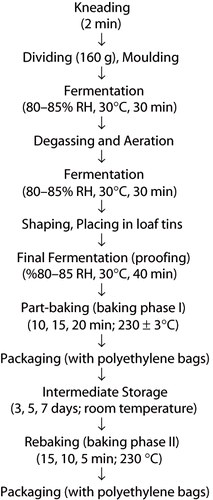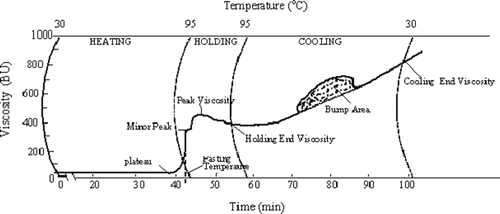Abstract
In this investigation, the white pan breads were part-baked for 10, 15, 20 minutes at 230°C with and without calcium propionate (0.2%), were stored at room temperature (20°C) for 3, 5, 7 days wrapped with two polyethylene bags. After storage, baking time of part-baked breads was completed to the baking time of control breads (25 minutes). Breads were subjected to softness analysis and pasting properties of bread crumb were determined using the Brabender Amylograph. Addition of Ca-propionate decreased softness value of crumb of bread rebaked after part-baked, while the peak, holding end and cooling end viscosities increased. The increase in initial baking time resulted in a decrease in the pasting temperature and softness value and an increase in the bump area and viscosity of the rebaked bread crumb. Bump area, water activity, softness value and peak, holding end and cooling end viscosities of crumb of the rebaked bread after part-baking decreased with longer (intermediate storage) time. Peak viscosity and water activity significantly correlated with softness of bread crumb rebaked following part-baking and storage at room temperature. Rebaking bread for 10 and 15 minutes after storage of 3 and 7 days at room temperature resulted in softer crumb than the control group.
INTRODUCTION
Bread is a food that has shorter shelf-life than most other processed foods. Bread rapidly loses freshness (texture and flavor) and is subject to mold spoilage. The limited shelf life of bread has an economical impact of billions of dollars for the world per year. Part-baked breads were developed to provide consumers with oven fresh bread at any desired time with a simple bake-off stage. A part-baked bread is fully baked as a conventional bread but displays a light crust color and has sufficient moisture for the development of desirable quality characteristics when rebaked.[Citation1,Citation2]
Bread staling has been extensively investigated because of its importance in determining product acceptability and shelf-life. Staling of bread is a highly complex phenomenon that is not yet fully understood. A number of tests, such as changes in crumbliness, water absorbing capacity, crumb compressibility, amount of soluble starch, amylose or amylopectin extracted, X-ray diffraction patterns and pasting properties of bread crumb have been used as direct or indirect indices of staling.[Citation3–5] Recent studies indicate that the crumb staling kinetics is also affected by the temperature of baking. Besides the factors listed above, a decisive effect on bread quality and its aging rate depends on storage conditions, particularly temperature.[Citation6,Citation7]
Many consumers refreshen (heat) aged bread to reverse the “staling” phenomenon. The physicochemistry of such refreshing is not fully understood.[Citation8] When a loaf of five-day-old bread was heated to 80°C, the firmness value dropped from 750 to 333 g, however, after bread was refreshened, firmness increased rapidly when that sample was held for two days after reheating.[Citation9] However, the staling of part-baked bread is slightly greater than that of refreshened breads, which is completely baked. Numerous studies have been done on the refreshing of starch gels, gluten gels, and breads. While retrogradation of amylose is not reversed by heat, retrograded amylopectin reverts to its amorphous state when energy equivalent to a 40–50°C temperature increase is applied. This implicates amylopectin as a major factor in bread staling. Unlike starch retrogradation in bread crumb, protein denaturation and moisture redistribution cannot be reversed by heating.[Citation10,Citation11]
The amylograph analysis has been employed by several researchers[Citation12–15] to study the pasting characteristics of aging bread crumb. Authors have suggested the possibility of using an amylograph analysis to measure the extent of staling. Yasunaga, Bushuk, and Irvine[Citation15] reported that viscosity of bread crumb in an amylograph analysis decreased with storage times. Xu, Chung, and Ponte[Citation14] found that amylograph readings of bread crumb were significantly correlated with crumb firmness.
The objectives of this article were to investigate the effects of baking period and storage on softness and pasting properties of part-baked white pan breads, to examine the relationship between bread crumb softness and pasting properties of bread crumb in an amylograph analysis, and to prolong the shelf-life of bread with the part-baking method.
MATERIALS AND METHODS
Wheat flour (13.65% water, 12.75% protein, 0.52% ash, 32.51% gluten, and 60.00% water absorption), fresh yeast, and salt were obtained from local market. Calcium propionate was purchased from Fluka Inc.
Bread was baked in a conventional oven according to the standard pup-loaf procedure, AACC method 10/09[Citation16] with some modifications. Ingredients mixed were: 100 g of flour, 58 g of water (at 30°C), 3 g of yeast, 1.5 g of NaCl, and 0.2 g of calcium propionate. One kilogram of dough was prepared. All ingredients were poured into a mixer (Stephan UM-5) and mixed for 2 minutes by applying low speed (1500 rpm). The production diagram of part-baked white pan bread is presented in . For production of part-baked white bread (baking phase I), baking times of 10, 15, and 20 minutes in a conventional oven at 230°C was used. After the baking process, breads were cooled for 1 hour and then packaged in 20 × 30 cm double folded nylon (polyethylene) pouches and stored for 3, 5, 7 days at room temperature (20°C). After storage, the part-baked breads were re-baked in the same oven. Baking periods of the part-baked breads were completed to baking time of the control breads (25 minutes) by rebaking process (baking phase II).
Physical and Chemical Analysis
Moisture content of flour was determined using an air circulation-drying chamber for 2.5 hours at 135 °C.[Citation17] The amount of protein was determined by the Kjeldahl method as described by Elgün et al.[Citation17]. Ash content was carried out at 910 ± 25°C[Citation18]. Wet gluten was determined by using Glutomatic 2000 instrument and water absorption of flour was determined by the Farinograph instrument.[Citation17] Breads were weighed within one hour after baking, volumes of breads were measured using colza grains and specific volumes were calculated.[Citation19] Water activity (aw) of bread crumbs were determined using the electrohigrometric method proposed by Münzing.[Citation20]
Pasting Properties of Bread Crumb
Samples of bread crumb were collected 12 hours after removal of the bread from the oven. The bread crumbs were removed from bread, sliced and stored in polyethylene bags at 30°C at a relative humidity of 85–90%. The freeze-dried crumb was ground on a Wiley mill to pass through a 60-mesh sieve. The Brabender Amylograph was used to examine the pasting properties of the bread crumb. The sample (55 g) was suspended in 350 ml of distilled water by agitation in a Waring Blender at low speed for 1 minute. The suspension was poured into the amylograph bowl, and the blender was rinsed with 100 ml of additional distilled water. The crumb suspension was heated uniformly from 30 to 95°C, held at 95°C for 15 minutes, and then cooled uniformly to 50°C. The information obtained from the amylograph curve () included plateau, peak, pasting temperature, viscosity (peak, holding and, cooling end), and bump area, (the area under the amylograph curve during the cooling cycle, as measured with a planimeter).[Citation13,Citation14]
Measurement of Bread Crumb Softness Value (Staling Rate)
Staling rate of bread was measured by compressibility with a penetrometer (PNR 10 – Penetrometer) as described by Maleki, Hoseney, and Mattern.[Citation21] Breads were stored in sealed polyethylene bags at room temperature (20°C) at 12 hours after removal of the bread from the oven. For crumb softness, two slices of 23 mm were taken from the center of the bread and each sample was compressed in five spots by a weigh of 54.6 g for 5 seconds. The compression spots were marked by holes on the four corners and center of a 6 × 6-cm cardboard template placed on the cut surface of each sample. Data for five points from each loaf were averaged to give the compressibility, measured with a penetrometer units (1 penetration unit (PU) = 0.1 mm).
Statistical Analysis
Statistical evaluations were performed with the SPSS/package (a completely randomized design procedure by SPSS).[Citation22] Differences between data were tested using the Duncan's range test (P < 0.05). The results of statistical analysis were shown as mean values ± standard deviations in tables.
RESULTS AND DISCUSSION
Results of Analyses for the Part-Baked White Pan Breads Without Storage
The amylograph technique was chosen for studying the behavior of wheat starch during the part-baking and rebaking process. shows the pasting curves obtained for the bread crumbs baked at different baking times (10, 15, 20, 25 minutes) and with and without Ca-propionate (antimicrobial), as measured at 12 hours after removal of the bread from the oven. Viscosity of the bread crumbs consistently decreased with length of baking time both with and without Ca-propionate (). This could be explained due to the high baking time causing more degradation of starch in white pan bread.
Figure 3 Amylograms for bread crumbs with (below) and without Ca-propionate (above) and baked at 10, 15, 20, 25 min at 230°C (C: control group).
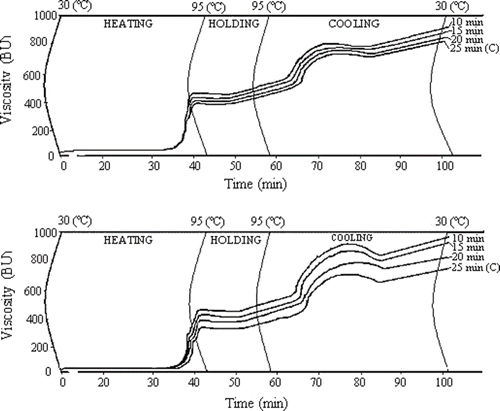
shows the effects of the antimicrobial additive (Ca-propionate) and baking time on the pasting properties, volume, aw, and softness of white pan bread crumb. The addition of Ca-propionate decreased loaf volume and softness of the bread crumb. Ca-propionate is an effective mold inhibitor but also reduces the fermentation rate of bakers yeast strains, it has a negative effect on volume and softness of bread.[Citation23] Bread crumb with 0.2% Ca-propionate gave a much bigger amylogram bump area and lower pasting temperature than bread without Ca-propionate. A minor peak was particularly prominent in bread crumb with Ca-propionate. The minor peak could be explained by the association of starch with other flour constituents during baking.[Citation12] With increasing baking time, a decrease occurred in loaf volume, softness of bread crumb, and an increase occurred in pasting temperature and bump area in both treatments, with and without Ca-propionate. The longer baking period, caused more damaged starch in the bread crumb. For this reason, pasting temperature of part-baked bread crumb increased with longer baking period. It has been reported that pasting temperature increased, as sugar level was increased.[Citation13]
Table 1 Crumb amylograph characteristics, volume, aw and softness values of breads at different baking times.
Results of Analyses for the White Pan Breads Rebaked After Part-Baked and Stored at Room Temperature
presents amylogram data, aw, and softness of part-baked white pan breads stored at room temperature (20 ±°C) before the second baking. Analysis of variance showed that baking and storage time significantly affected (P < 0.01) pasting temperature and bump area of bread crumb (). The increase in initial baking time resulted in a significant decrease (P < 0.01) in the pasting temperature and an increase (P < 0.01) in bump area. However, the increase in storage time of part-baked breads resulted in increase (P < 0.01) in pasting temperature and decrease (P < 0.01) in bump area. This could be explained by the fact that sugar arising from degradation of starch occurred during the storage period, which increases pasting temperature in the crumb amylogram. D'Appolonia and MacArthur[Citation24] reported that pasting temperature increased as sugar levels were increased. Pasting temperature and bump area were not determined in bread crumb without Ca-propionate stored for 5 and 7 days, because of the presence of rope.
Table 2 Crumb amylograph characteristics, aw and softness values for part-baked breads stored at room temperature (20 ± 2°C) before the second baking.
Table 3 Comparison of overall average amylogram readings between treatmentsFootnote a .
Softness results and the amylogram readings (peak, holding end, and cooling end viscosities) of the crumbs of rebaked bread following for various durations of part-baking and storage and formulated with and without antimicrobial additive (Ca-propionate) are shown in . Addition of Ca-propionate resulted in a lower (P < 0.01) softness of bread crumb. This was partly because of lower yeast activity and lower bread volume for the dough with Ca-propionate. Some studies[Citation25,Citation26] have reported an increase in firmness with decreasing volume of breads. The viscosities (peak, holding end and cooling end) of bread crumb increased (P < 0.01) in breads with Ca-propionate.
Table 4 Effect of antimicrobial additive (Ca-propionate) on pasting properties and softness of bread crumbFootnote a .
summarizes the results of softness and viscosity values of crumbs rebaked bread after part-baking at different baking times and stored for different storage periods. Softness value of the bread crumb decreased (P < 0.01) with increasing initial baking time. During baking in oven, water vaporizes and moisture content of bread crumb decreases. Moisture content also has been shown to be inversely proportional to the softness of bread crumb.[Citation27] As the initial baking time was increased, peak, holding end and cooling end viscosity values of bread crumb increased (P < 0.01).
Table 5 Effect of primary baking time on pasting properties and softness of bread crumbFootnote a .
Water activity, softness value, peak, holding end and cooling end viscosity values of bread crumb decreased (P < 0.01) continuously during storage of the bread rebaked after part-baking and storage (). Many studies showed that firmness and moisture content of bread crumb increased linearly with time and water activity and moisture content also influenced bread staling and firmness.[Citation9,Citation28] In bread, water acts as a plasticizer. When moisture decreases, it accelerates the formation cross-links between starch and protein and, thus, the bread firms faster.[Citation4] Peak, holding end and cooling end viscosities of bread crumb decreased sharply on the third day of storage, but decreased less thereafter. These results were similar to the findings of Banecki,[Citation29] D'Appolonia and Morad,[Citation30] Xu, Chung, and Ponte,[Citation14] who reported that viscosity of bread crumb with the amylograph decreased during storage time of bread.
Table 6 Effect of intermediate storage time on pasting properties, aw and softness of bread crumbFootnote a .
The effects of initial baking times during storage of bread on bread crumb water activity are shown in . Water activity of crumb of rebaked bread after part-baking for 10, 15, and 20 minutes and intermediate storage decreased (P < 0.01) sharply in the 3-day-old bread, but decreased (P < 0.01) less thereafter. The lowest water activity was obtained with 3-day-old bread and 20-min-initial baking time. There was little change in water activity of breads with the 10-min to 15-min-initial baking time during 5 days of storage. In the same way, very minor changes in water activity took place in the bread crumbs of breads subjected to intermediate storage of 7 days. Water activity of bread crumb decreased as the initial baking and storage time of bread increased. The same variation (P < 0.01) was also observed in softness and peak viscosity values of the bread crumbs (, ).
Figure 4 Effect of initial baking times (10 min (○), 15 min (□), 20 min (Δ)) on changes in bread crumb water activity during storage. (C: control group).
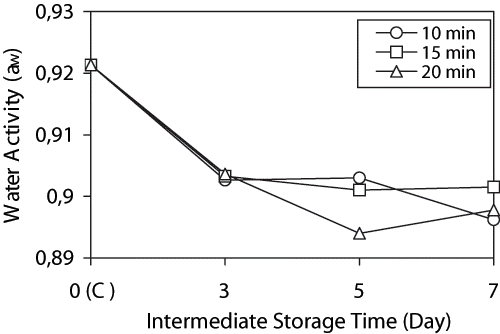
Figure 5 Effect of initial baking times (10 min (○), 15 min (□), 20 min (Δ)) and duration of intermediate storage on bread crumb softness (PU: penetration unit, C: control group).
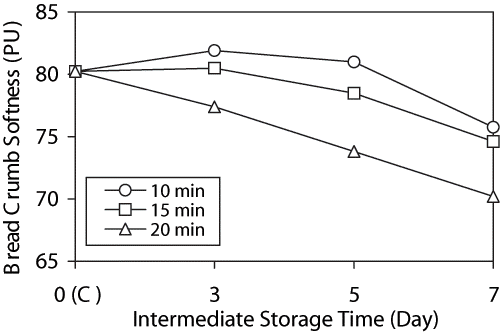
Figure 6 Effect of initial baking times (10 min (○), 15 min (□), 20 min (Δ)) on changes in peak viscosity of bread crumb during storage. (C: control group).
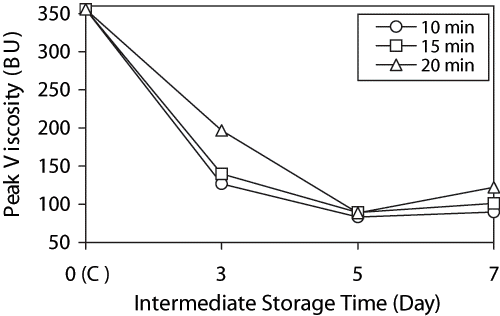
As shown in , the increase of storage period decreased softness of bread crumb, more noticeably (P < 0.01) with 20-minute-initial-baking time than with 10 and 15-minute-initial-baking time. But, 10 and 15 minute-initial-baking on 3rd and 5th day of room temperature storage and 15 minute-initial-baking on 3rd day of room temperature storage gave crumb softness the same as control group breads or softer. To overcome staling of bread and to resolubilise crystalline amylose molecules a temperature of 60°C was required.[Citation31]
Peak viscosity of bread crumb rebaked after part-baking and storage at room temperature decreased (P < 0.01) at all initial baking times with increasing length of storage period, more noticeable at 10 and 15-minute-initial-baking times (). Peak viscosities of bread crumb slurries were reported to decrease with aging of the crumbs.[Citation32]
shows correlation coefficients of amylogram readings (peak, holding end, and cooling viscosities), softness and water activity of bread crumb rebaked after part-baking and storage at room temperature. The softness values of bread crumbs produced significant positive correlation with peak viscosity (∝ = 0.1) and water activity (∝ = 0.05) of bread crumbs. Similar results were reported by Xu, Chung, and Ponte.[Citation14] No significant correlation could be found between softness value and holding and cooling end viscosities of bread crumbs. However, the other parameters such as peak, holding end, cooling end viscosities and water activity produced highly significant positive correlation when compared to each other.
Table 7 Correlation coefficients of amylogram readings, softness and water activity of white pan bread crumb.
CONCLUSION
The results of this research showed that the addition of an anti microbial preservative (Ca-propionate) significantly affected shelf-life of part-baked bread during storage at room temperature, because after 5 and 7 days of storage at room temperature, molding and rope spoilage occurred in the bread without Ca-propionate addition. The addition of Ca-propionate also had a significant effect on the quality of bread rebaked after part-baking and storage. The addition of an anti-microbial preservative to bread produced with a two-step baking process is recommended for industrial practice, especially when storage is at room temperature. Initial baking and storage time of part-baked bread had a significant effect on the amylogram readings (peak, holding end and cooling end viscosities) and softness value of rebaked bread crumb. The crumb softness results indicate that prebaking time and storage period of part-baked bread determine the hardening rate during aging. Peak viscosity and water activity were significantly correlated with crumb softness of rebaked breads following part-baking and storage at room temperature, while no other amylogram readings were significantly correlated with crumb softness. The rebaked bread part-baked for 10 and 15 min following storage of 3 and 7 days at room temperature gave softer crumb than the control group. As a result, the short initial baking time or the long rebaking time is recommended for a two-step baking process (rebaking after part-baking and storage).
REFERENCES
- Baik , M. and Chinachoti , P. 2000 . Moisture Redistribution and Phase Transitions During Bread Staling . Cereal Chem , 77 ( 4 ) : 484 – 488 .
- Leuschner , R.G.K. , O'Callaghan , M.J.A. and Erendt , E.K. 1999 . Moisture and Microbial Quality of Part-baked Breads as Related to Storage and Rebaking Conditions . Int. J. Food Sci. Tech , 64 ( 3 ) : 543 – 546 .
- Gil , M.J. , Callejo , M.J. and Rodriguez , G. 1997 . Effect of Water Content and Storage Time on White Pan Bread Qulity: Instrumental Evaluation . Z. Lebensm. Unters Forsch , 205 : 268 – 273 .
- He , H. and Hoseney , R.C. 1990 . Changes in Bread Firmness and Moisture During Long-term Storage . Cereal Chem , 67 : 603 – 605 .
- Sidhu , J.S. , Al-Sager , J. and Al-Zenki , S. 1997 . Comparison of Methods for the Assessment of the Extent of Staling in Bread . Food Chem , 58 ( 1–2 ) : 161 – 167 .
- Fik , M. and Macura , R. 2001 . Quality Changes During Frozen Storage and Thawing of Mixed Bread . Nahrung , 45 ( 2 ) : 138 – 142 .
- Giovanelli , G. , Peri , C. and Borri , V. 1997 . Effects of Baking Temperature on Crumb-Staling Kinetics . Cereal Chem , 74 ( 6 ) : 710 – 714 .
- Rogers , D.E. , Doescher , L.C. and Hoseney , R.C. 1990 . Texture Characteristics of Reheated Bread . Cereal Chem , 67 ( 2 ) : 188 – 191 .
- Ghiasi , K. , Hoseney , R.C. , Zeleznak , K. and Rogers , D.E. 1984 . Effects of Waxy Barley Starch and Reheating on Firmness of Bread Crumb . Cereal Chem , 61 ( 4 ) : 281 – 285 .
- LeMeste , M. , Huang , V.T. , Panama , J. , Anderson , G. and Lentz , R. 1992 . Glass Transition of Bread . Cereral Foods World , 37 ( 3 ) : 264 – 266 .
- Pisesookbunterng , W. and D'Appolonia , B.L. 1983 . Bread Staling Studies. I. Effect of Surfactans on Moisture Migration from Crumb to Crust and Firmness Values of Bread Crumb . Cereal Chem , 60 ( 4 ) : 298 – 301 .
- Kim , S.K. and D'Appolonia , B.L. 1977 . Bread Staling Studies. II. Effect of Protein Content and Storage Temperature on the Role of Starch . Cereal Chem , 54 ( 2 ) : 216 – 220 .
- Morad , M.M. and D'Appolonia , B.L. 1980 . Effect of Surfactants and Baking Procedure on Total Water-Solubles and Soluble Starch in Bread Crumb . Cereal Chem , 57 ( 2 ) : 141 – 144 .
- Xu , A. , Chung , O.K. and Ponte , J.G. 1992 . Bread Crumb Amylograph Studies. I. Effects of Storage Time, Shortening, Flour Lipids, and Surfactants . Cereal Chem , 69 ( 5 ) : 495 – 501 .
- Yasunaga , T. , Bushuk , W. and Irvine , G. N. 1968 . Gelatinization of Starch During Bread-baking . Cereal Chem , 45 : 269 – 279 .
- American Association of Cereal Chemists . 1983 . “ Methods 10–09, 44–15, 44–18 ” . In Approved Methods of the AACC , St, Paul, MN : AACC .
- Elgün , A. , Ertugay , Z. , Certel , M. and Kotancilar , H.G. 1999 . “ Guide book for analytical quality control and laboratory for cereal and cereal products ” . In Ataturk Univ. Agric. Fac 238 Erzurum Publication No:335
- International Association for Cereal Chemists . 1967 . Approved Methods , Detmold : TCC .
- Lee , C.C. and Hoseney , R.C. 1982 . Varriona-Martson, E. Development of a Laboratory-scale Single-stage Cake Mix . Cereal Chem , 59 ( 5 ) : 389 – 392 .
- Münzing , K. 1987 . Wasser ein Wichtiger Physikalllisc her Qualitatsfaktor bei Getreide . Getreide Mehl und Brot , 41 ( 12 ) : 362
- Maleki , M. , Hoseney , R.C. and Mattern , P.J. 1980 . Effects of Loaf Volume, Moisture Content, and Protein Quality on the Softness and Staling Rate of Bread . Cereal Chem , 57 ( 2 ) : 138 – 140 .
- SPSS . 1996 . “ SPSS for Windows Release 10.01 ” . Chicago : SPSS Inc. .
- Karaoğlu , M.M. 2002 . “ Technological and Microbiological Properties of Part-baked Breads Stored in Different Time and Temperature ” . Erzurum : Academic Press .
- D'Appolonina , B.L. and Macarthur , L.A. 1974 . Effect of Ingredients on Continuous Bread Crumb Pasting Characteristics . Cereal Chem , 51 ( 2 ) : 195 – 202 .
- Axford , D.W.E. , Colwell , K.H. , Cornrord , S.J. and Elton , J.A.H. 1968 . Effect of Loaf Specific Volume on the Rate and Extent of Staling in Bread . J. Sci. Food Agric , 19 : 95 – 101 .
- Stöllman , U. and Lundgren , B. 1987 . Texture Changes in White Bread: Effects of Processing and Storage . Cereal Chem , 64 ( 4 ) : 230 – 236 .
- Rogers , D.E. , Zeleznak , K.J. , Lai , C.S. and Hoseney , R.C. 1988 . Effect of Native Lipids, Shortening, and Bread Moisture on Bread Firming . Cereal Chem , 65 ( 5 ) : 398 – 401 .
- Czuchajowska , Z. and Pomeranz , Y. 1989 . Differential Scanning Calorimetry, Water Activity, and Moisture Contents in Crumb Center and Near-crust Zones of Bread During Storage . Cereal Chem , 66 ( 4 ) : 305 – 309 .
- Banecki , H. 1972 . Changes in the Enzymatically Isolated Starch During the Aging of Wheat and Rye Bread . Getreide Mehl und Brot , 26 : 2
- D'Appolonia , B. L. and Morad , M.M. 1981 . Bread Staling . Cereal Chem , 58 ( 3 ) : 186 – 190 .
- Leuschner , R.G.K. , O'Callaghan , M.J.A. and Erendt , E.K. 1997 . Optimization of Baking Parameters of Part-baked and Rebaked Irish Brown Soda Bread by Evaluation of Some Quality Characteristics . Int. J. Food Sci. Tech , 32 : 487 – 493 .
- Karim , A.A. , Norziah , M.H. and Seow , C.C. 2000 . Methods for the Study of Starch Retrogradation . Food Chem , 71 : 9 – 36 .
